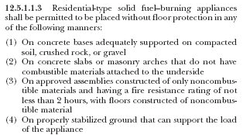Webmaster said:
(my guess) They bought the stove used.......and it did not have the shield......
Easy enough to make or order from Woodstock.
Again, a slab on earth is certainly a lot different than a frame floor. On a frame or combustible floor there is no doubt that a BHS would be good in most all cases. But on a garage, shop, basement slab or dirt/gravel (as per NFPA) there is nothing to "protect" from.
Jim, is that plywood on the sub floor? So all they had was the one layer of 5/8" and tile? Mineral board (as you found out) is not a good base for tiles (too soft)......
As I remember, the Defiant and most VC's required a bottom heat shield (optional, amazingly enough) over anything but slab over earth.
I got a real kick reading others saying it was OK to burn Bum357 stove without knowing if there were children or pets in the home or if there were any combustibles at the end of the hearth pad? Heating appliances are not toys and ARE dangerous! Nothing like telling a new stove owner you can cut corners and the install instructions are crapolla!
Bum357 stated, "
i was reading the manuel and it stated that you must use the lower heat shield". I imagine that word "MUST" should have been "SOMETIMES" or "IF CONVENIENT". Of course we all know that when Bum357 gets his inspection the Inspector will just overlook it and if the house ever burns down because the heat shield wasn't installed the insurance company will just let it pass. :coolhmm:
Of course Bum357 is going to tell them that the people on Hearth.com said it was just fine to not use the shield and everything will be OK. :roll: I believe a lot of people think the Instruction Manual as just a piece of paper to be used in their first burn.
As per the Defiant, the heat shields were optional and not a requirement as per the installation instructions. We were running a very dangerous situation and we knew it needed to be corrected.
The stove was here when we purchased the home. The 2 boards standing vertical are probably 1/4" asbestos, very rigid, like you would see on exterior asbestos siding. The exposed sub-floor is a rigid fireproof soundboard used for commercial purposes. There is 3/4" plywood sub-floor under that. The guy who lived here prior was a commercial builder and built the home.
We really didn't know how hot it got under the stove until we started having problems with the tile under the stove. The grout had turned to dust and the tiles were delaminating from the backer board. It got so hot that you could not place your hand on the tile under the stove without getting seriously burned. In front of the stove also had some extreme temps (radiant heat we imagine) which we didn't really notice since we are side loaders.
I realize that Bum357 stove is on non-combustibles, but hearth temps can get extreme as we experienced. Craig, imagine a toddler wondering near the stove?
I built a simple heat shield and would never burn without it! I did some temp readings after cranking up the stove and directly under the stove it was 110dgs and just past the stove's lip it was 123 degrees. Still hot enough to burn a child's feet with the new heat shield installed.
Off my firebox,
Jim



 hh:
hh: